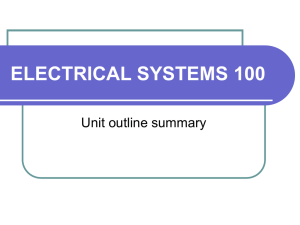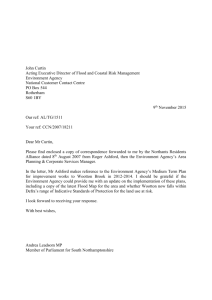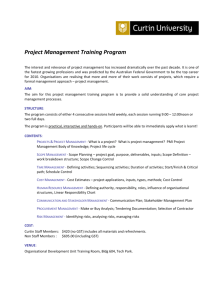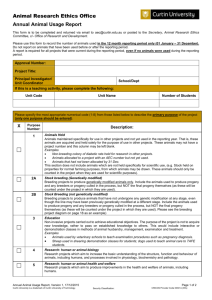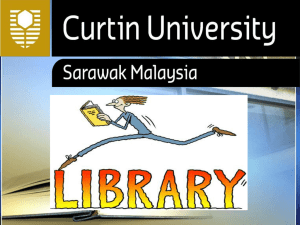Page 1 Unit study package code: ASTR3000 Mode of study: Internal
advertisement
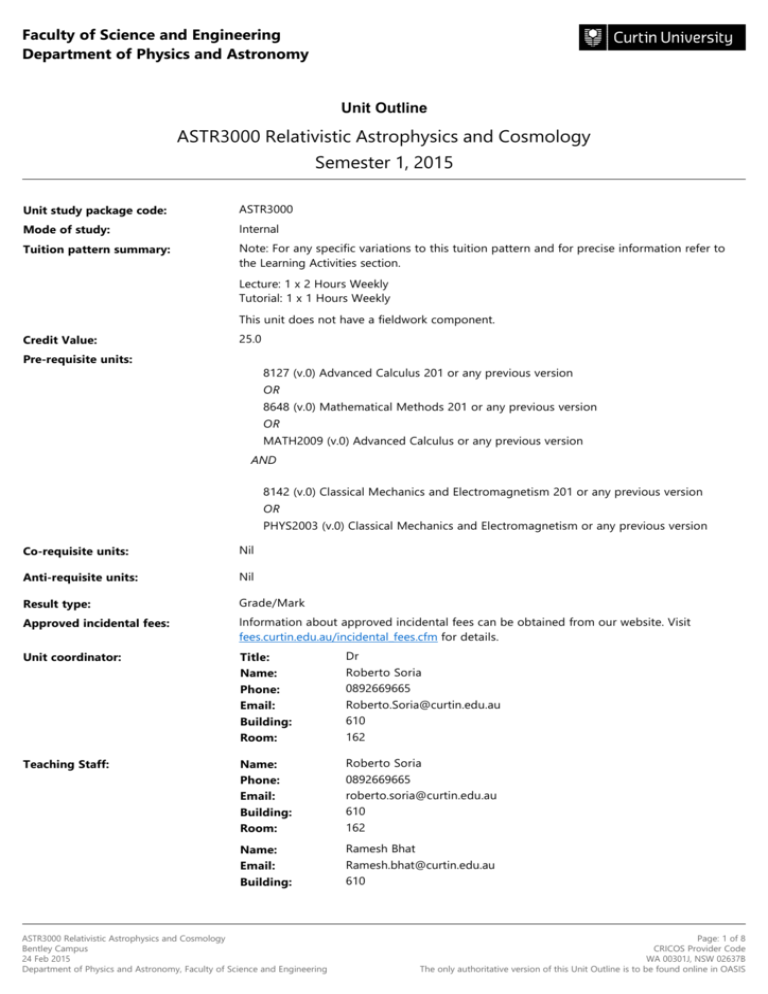
Faculty of Science and Engineering Department of Physics and Astronomy Unit Outline ASTR3000 Relativistic Astrophysics and Cosmology Semester 1, 2015 Unit study package code: ASTR3000 Mode of study: Internal Tuition pattern summary: Note: For any specific variations to this tuition pattern and for precise information refer to the Learning Activities section. Lecture: 1 x 2 Hours Weekly Tutorial: 1 x 1 Hours Weekly This unit does not have a fieldwork component. Credit Value: 25.0 Pre-requisite units: 8127 (v.0) Advanced Calculus 201 or any previous version OR 8648 (v.0) Mathematical Methods 201 or any previous version OR MATH2009 (v.0) Advanced Calculus or any previous version AND 8142 (v.0) Classical Mechanics and Electromagnetism 201 or any previous version OR PHYS2003 (v.0) Classical Mechanics and Electromagnetism or any previous version Co-requisite units: Nil Anti-requisite units: Nil Result type: Grade/Mark Approved incidental fees: Information about approved incidental fees can be obtained from our website. Visit fees.curtin.edu.au/incidental_fees.cfm for details. Unit coordinator: Title: Name: Phone: Email: Building: Room: Dr Roberto Soria 0892669665 Roberto.Soria@curtin.edu.au 610 162 Teaching Staff: Name: Phone: Email: Building: Room: Roberto Soria 0892669665 roberto.soria@curtin.edu.au 610 162 Name: Email: Building: Ramesh Bhat Ramesh.bhat@curtin.edu.au 610 ASTR3000 Relativistic Astrophysics and Cosmology Bentley Campus 24 Feb 2015 Department of Physics and Astronomy, Faculty of Science and Engineering Page: 1 of 8 CRICOS Provider Code WA 00301J, NSW 02637B The only authoritative version of this Unit Outline is to be found online in OASIS Faculty of Science and Engineering Department of Physics and Astronomy Angela Dunleavy 0892664669 angela.dunleavy@icrar.org 610 Administrative contact: Name: Phone: Email: Building: Learning Management System: Blackboard (lms.curtin.edu.au) ASTR3000 Relativistic Astrophysics and Cosmology Bentley Campus 24 Feb 2015 Department of Physics and Astronomy, Faculty of Science and Engineering Page: 2 of 8 CRICOS Provider Code WA 00301J, NSW 02637B The only authoritative version of this Unit Outline is to be found online in OASIS Faculty of Science and Engineering Department of Physics and Astronomy Acknowledgement of Country We respectfully acknowledge the Indigenous Elders, custodians, their descendants and kin of this land past and present. Syllabus This unit begins with a detailed, mathematical treatment of Einstein's special theory of relativity and its implications for observational astronomy. These include apparent superluminal motion in the jets of active galactic nuclei, Doppler boosting, stellar aberration and so on. This leads into a qualitative description of the structure of space-time and Einstein's general theory of relativity. Basic concepts such as the space-time metric and its curvature in the presence of mass or energy are introduced, but detailed mathematical details are left for 4th year units. Various cosmological concepts are discussed, including how the ultimate fate of the universe is linked to its energy density. Current models of the evolution of the universe are explored, including the idea of an inflationary period shortly after the big bang. Observational measurements of the rate of expansion of the universe throughout its history are discussed, including recent evidence that suggests the rate of expansion is accelerating.Sources of uncertainty in these data are also considered. Introduction Relativistic Astrophysics and Cosmology 301 is an exciting unit that delves into the strange world of Einstein's theories of relativity. Students will be introduced to the advanced mathematical foundation concepts upon which these theories are built, including 4vectors and tensors. These tools will be used to predict various unusual properties of astronomical systems and astrophysicists Ramesh Bhat and Rob Soria will explain the observational evidence that has verified the most important of Einstein's predictions to date. Students will explore the space-time metric and encounter the notion that gravity can be elegantly modelled as a geometric effects – the bending of space-time. After establishing a solid foundation, this unit moves on to two specific applications of Einstein's equations: black holes and cosmology. For example, students will use the solutions of Einstein's equations to model the expansion of the universe for different compositions of matter, radiation and dark energy.This is a rewarding but challenging unit suited to students with a strong physics and mathematics background. Unit Learning Outcomes All graduates of Curtin University achieve a set of nine graduate attributes during their course of study. These tell an employer that, through your studies, you have acquired discipline knowledge and a range of other skills and attributes which employers say would be useful in a professional setting. Each unit in your course addresses the graduate attributes through a clearly identified set of learning outcomes. They form a vital part in the process referred to as assurance of learning. The learning outcomes tell you what you are expected to know, understand or be able to do in order to be successful in this unit. Each assessment for this unit is carefully designed to test your achievement of one or more of the unit learning outcomes. On successfully completing all of the assessments you will have achieved all of these learning outcomes. Your course has been designed so that on graduating we can say you will have achieved all of Curtin's Graduate Attributes through the assurance of learning process in each unit. On successful completion of this unit students can: Graduate Attributes addressed 1 Derive expressions for space distances, time intervals, energy and momentum that can be used to explain astronomical observations and other physical measurements involving objects moving at a speed close to the speed of light 2 Research a particular topic in astrophysics, selecting only information directly relevant to the topic. Present a concise summary of the above research to a group of peers, satisfactorily answering questions that arise 3 Reformulate simple laws of physics for a general case where spacetime is not flat, and determine the trajectory of objects in strong gravity fields (not consistent with Newton's law of gravity) 4 Identify the key parameters that determine the expansion rate of the universe in the standard cosmological model, compare the model predictions with the observations and examine the possibility of alternative explanations for the same data ASTR3000 Relativistic Astrophysics and Cosmology Bentley Campus 24 Feb 2015 Department of Physics and Astronomy, Faculty of Science and Engineering Page: 3 of 8 CRICOS Provider Code WA 00301J, NSW 02637B The only authoritative version of this Unit Outline is to be found online in OASIS Faculty of Science and Engineering Department of Physics and Astronomy Curtin's Graduate Attributes Apply discipline knowledge Thinking skills Information skills (use analytical skills to solve problems) (confidence to investigate new ideas) Communication skills Technology skills International perspective Cultural understanding (value the perspectives of others) (value the perspectives of others) Learning how to learn (apply principles learnt to new situations) (confidence to tackle unfamiliar problems) Professional Skills (work independently and as a team) (plan own work) Find out more about Curtin's Graduate attributes at the Office of Teaching & Learning website: ctl.curtin.edu.au Learning Activities This unit consists of a series of interactive round-table lectures, backed up by tutorial and workshop sessions. Lectures run for two hours with a 10-minute break half way through. Concepts will be introduced and explained using diagrams, examples, animations etc. where possible. Examples will be discussed during the lectures in order to reinforce the concepts introduced. Tutorials and workshops will run for 1 hour each. Tutorials provide a chance for students to work on problem solving methods with the help of their tutor. Activities will include group problem solving and individual practice questions. Workshops will involve computer exercises ranging from simulations of relativistic scenarios to computer-aided mathematics. Questions and discussion are encouraged at all times. Learning Resources Essential texts The required textbook(s) for this unit are: l Special Relativity”, Anthony P. French, Van Nostrand Reinhold (UK), 1986 Recommended texts You do not have to purchase the following textbooks but you may like to refer to them. l Principles of Cosmology and Gravitation”, Michael V. Berry, CRC Press, 1989 l "Cosmological Physics”, John A. Peacock, Cambridge University Press, 2001 l "A First Course in General Relativity”, Bernard F. Schutz, Cambridge Uni. Press, 1985. l "General Relativity”, I.R. Kenyon, Oxford Science Publications, 1990 ASTR3000 Relativistic Astrophysics and Cosmology Bentley Campus 24 Feb 2015 Department of Physics and Astronomy, Faculty of Science and Engineering Page: 4 of 8 CRICOS Provider Code WA 00301J, NSW 02637B The only authoritative version of this Unit Outline is to be found online in OASIS Faculty of Science and Engineering Department of Physics and Astronomy Assessment Assessment schedule Task 1 2 3 4 Value % Unit Learning Outcome(s) Assessed Date Due Assignment 1 15 percent Week: 5 Day: 30/3/15 Time: 1pm 1 Special Relativity Talk 10 percent Week: 5 Day: 30/3/15 Time: 1pm 2 Assignment 2 25 percent Week: 10 Day: 11/5/15 Time: 1pm 3,4 Final Examination 50 percent Week: 14 Day: 15/6/15 Time: 1pm 1,3,4 Detailed information on assessment tasks 1. Special Relativity assignment 2. Student presentations 3. General Relativity assignment 4. Final exam Pass requirements In order to pass the unit, an overall grade of at least 50% must be obtained. Fair assessment through moderation Moderation describes a quality assurance process to ensure that assessments are appropriate to the learning outcomes, and that student work is evaluated consistently by assessors. Minimum standards for the moderation of assessment are described in the Assessment and Student Progression Manual, available from policies.curtin.edu.au/policies/teachingandlearning.cfm Late assessment policy This ensures that the requirements for submission of assignments and other work to be assessed are fair, transparent, equitable, and that penalties are consistently applied. 1. 2. All assessments students are required to submit will have a due date and time specified on this Unit Outline. Students will be penalised by a deduction of ten percent per calendar day for a late assessment submission (eg a mark equivalent to 10% of the total allocated for the assessment will be deducted from the marked value for every day that the assessment is late). This means that an assessment worth 20 marks will have two marks deducted per calendar day late. Hence if it was handed in three calendar days late and given a mark of 16/20, the student would receive 10/20. An assessment more than seven calendar days overdue will not be marked and will receive a mark of 0. Assessment extension A student unable to complete an assessment task by/on the original published date/time (eg examinations, tests) or due date/time (eg assignments) must apply for an assessment extension using the Assessment Extension form (available from the Forms page at students.curtin.edu.au/administration/) as prescribed by the Academic Registrar. It is the responsibility of the student to demonstrate and provide evidence for exceptional circumstances beyond the student's control that prevent them from completing/submitting the assessment task. The student will be expected to lodge the form and supporting documentation with the unit coordinator before the assessment date/time or due date/time. An application may be accepted up to five working days after the date or due date of the assessment task where the student is able to provide an acceptable explanation as to why he or she was not able to submit the application prior to the assessment date. An application for an assessment extension will not be accepted after the date of the Board of Examiners' ASTR3000 Relativistic Astrophysics and Cosmology Bentley Campus 24 Feb 2015 Department of Physics and Astronomy, Faculty of Science and Engineering Page: 5 of 8 CRICOS Provider Code WA 00301J, NSW 02637B The only authoritative version of this Unit Outline is to be found online in OASIS Faculty of Science and Engineering Department of Physics and Astronomy meeting. Deferred assessments If your results show that you have been granted a deferred assessment you should immediately check your OASIS email for details. Deferred examinations/tests will be held from 01/07/2015 to 13/07/2015 . Notification to students will be made after the Board of Examiners’ meeting via the Official Communications Channel (OCC) in OASIS. Supplementary assessments Supplementary assessments are not available in this unit. Referencing style The referencing style for this unit is Chicago. More information can be found on this style from the Library web site: library.curtin.edu.au. Academic Integrity (including plagiarism and cheating) Any conduct by a student that is dishonest or unfair in connection with any academic work is considered to be academic misconduct. Plagiarism and cheating are serious offences that will be investigated and may result in penalties such as reduced or zero grades, annulled units or even termination from the course. Plagiarism occurs when work or property of another person is presented as one's own, without appropriate acknowledgement or referencing. Submitting work which has been produced by someone else (e.g. allowing or contracting another person to do the work for which you claim authorship) is also plagiarism. Submitted work is subjected to a plagiarism detection process, which may include the use of text matching systems or interviews with students to determine authorship. Cheating includes (but is not limited to) asking or paying someone to complete an assessment task for you or any use of unauthorised materials or assistance during an examination or test. For more information, including student guidelines for avoiding plagiarism, refer to the Academic Integrity tab in Blackboard or academicintegrity.curtin.edu.au. Additional information Enrolment It is your responsibility to ensure that your enrolment is correct - you can check your enrolment through the eStudent option on OASIS, where you can also print an Enrolment Advice. Student Rights and Responsibilities It is the responsibility of every student to be aware of all relevant legislation, policies and procedures relating to their rights and responsibilities as a student. These include: l l l l l the Student Charter the University's Guiding Ethical Principles the University's policy and statements on plagiarism and academic integrity copyright principles and responsibilities the University's policies on appropriate use of software and computer facilities Information on all these things is available through the University's "Student Rights and Responsibilities website at: students.curtin.edu.au/rights. ASTR3000 Relativistic Astrophysics and Cosmology Bentley Campus 24 Feb 2015 Department of Physics and Astronomy, Faculty of Science and Engineering Page: 6 of 8 CRICOS Provider Code WA 00301J, NSW 02637B The only authoritative version of this Unit Outline is to be found online in OASIS Faculty of Science and Engineering Department of Physics and Astronomy Student Equity There are a number of factors that might disadvantage some students from participating in their studies or assessments to the best of their ability, under standard conditions. These factors may include a disability or medical condition (e.g. mental illness, chronic illness, physical or sensory disability, learning disability), significant family responsibilities, pregnancy, religious practices, living in a remote location or another reason. If you believe you may be unfairly disadvantaged on these or other grounds please contact Student Equity at eesj@curtin.edu.au or go to http://eesj.curtin.edu.au/student_equity/index.cfm for more information You can also contact Counselling and Disability services: http://www.disability.curtin.edu.au or the Multi-faith services: http://life.curtin.edu.au/health-and-wellbeing/about_multifaith_services.htm for further information. It is important to note that the staff of the university may not be able to meet your needs if they are not informed of your individual circumstances so please get in touch with the appropriate service if you require assistance. For general wellbeing concerns or advice please contact Curtin's Student Wellbeing Advisory Service at: http://life.curtin.edu.au/health-and-wellbeing/student_wellbeing_service.htm Recent unit changes We welcome feedback as one way to keep improving this unit. Students are encouraged to provide unit feedback through eVALUate, Curtin's online student feedback system (see evaluate.curtin.edu.au/info/). To view previous student feedback about this unit, search for the Unit Summary Report at evaluate.curtin.edu.au/student/unit_search.cfm. See evaluate.curtin.edu.au to find out when you can eVALUate this unit. Recent changes to this unit include: Ramesh Bhat will teach Special Relativity, replacing Steven Tingay. ASTR3000 Relativistic Astrophysics and Cosmology Bentley Campus 24 Feb 2015 Department of Physics and Astronomy, Faculty of Science and Engineering Page: 7 of 8 CRICOS Provider Code WA 00301J, NSW 02637B The only authoritative version of this Unit Outline is to be found online in OASIS Faculty of Science and Engineering Department of Physics and Astronomy Program calendar Program Calendar – Semester 1 2015 Week Begin Date 2-hr Lecture 1-hr Tutorial Assessment Due Orientation 23 February 1. 2 March SR Lecture (RB) SR Tutorial (RB) 2. 9 March SR Lecture (RB) SR Tutorial (RB) 3. 16 March SR Lecture (RB) SR Tutorial (RB) 4. 23 March SR Lecture (RB) SR Tutorial (RB) 5. 30 March Student talks SR Tutorial (RB) 30 March (RB) 6. 6 April Tuition Free Week 7. 13 April Tuition Free Week 8. 20 April 9. 27 April 10. GR Lecture (RS) GR Tutorial (RS) GR Lecture (RS) GR Tutorial (RS) 4 May GR Lecture (RS) GR Tutorial (RS) 11. 11 May GR Lecture (RS) GR Tutorial (RS) 11 May (RS1) 12. 18 May GR Lecture (RS) GR Tutorial (RS) 13. 25 May GR Lecture (RS) GR Tutorial (RS) 14. 1 June GR Lecture (RS) GR Tutorial (RS) 1 June (RS2) 15. 8 June Study week 16. 15 June Exams week 1 17 22 June Exams week 2 ASTR3000 Relativistic Astrophysics and Cosmology Bentley Campus 24 Feb 2015 Department of Physics and Astronomy, Faculty of Science and Engineering Page: 8 of 8 CRICOS Provider Code WA 00301J, NSW 02637B The only authoritative version of this Unit Outline is to be found online in OASIS
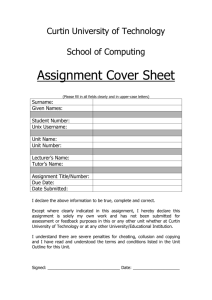
![Assignment coversheet (single) [ 48KB]](http://s3.studylib.net/store/data/008375796_1-47bef2c2c4eb4b7696d1fc3a80518558-300x300.png)
![Assignment coversheet (group) [ 126KB]](http://s3.studylib.net/store/data/008375797_1-0b6687da490940610c4ecb23456dda46-300x300.png)
